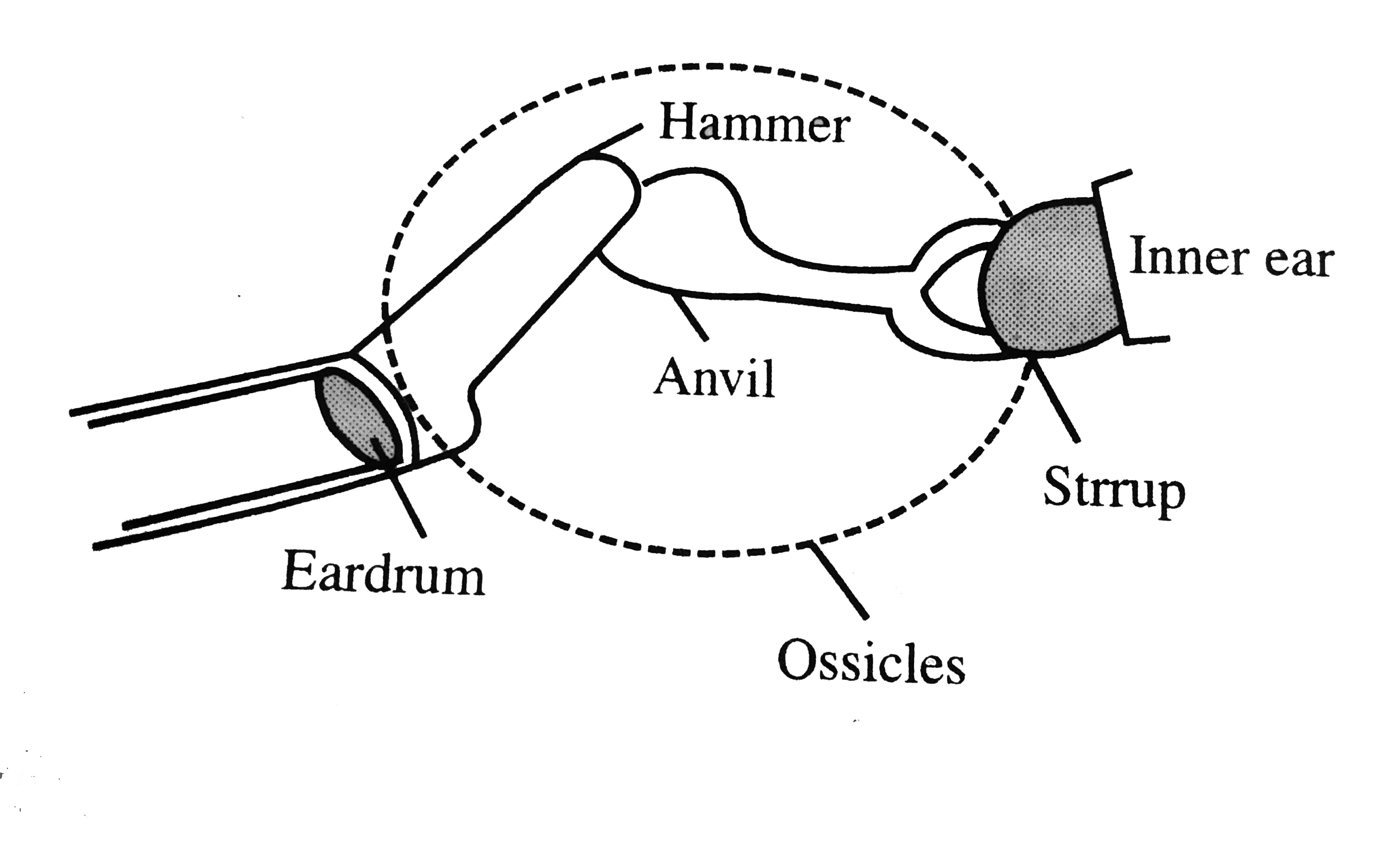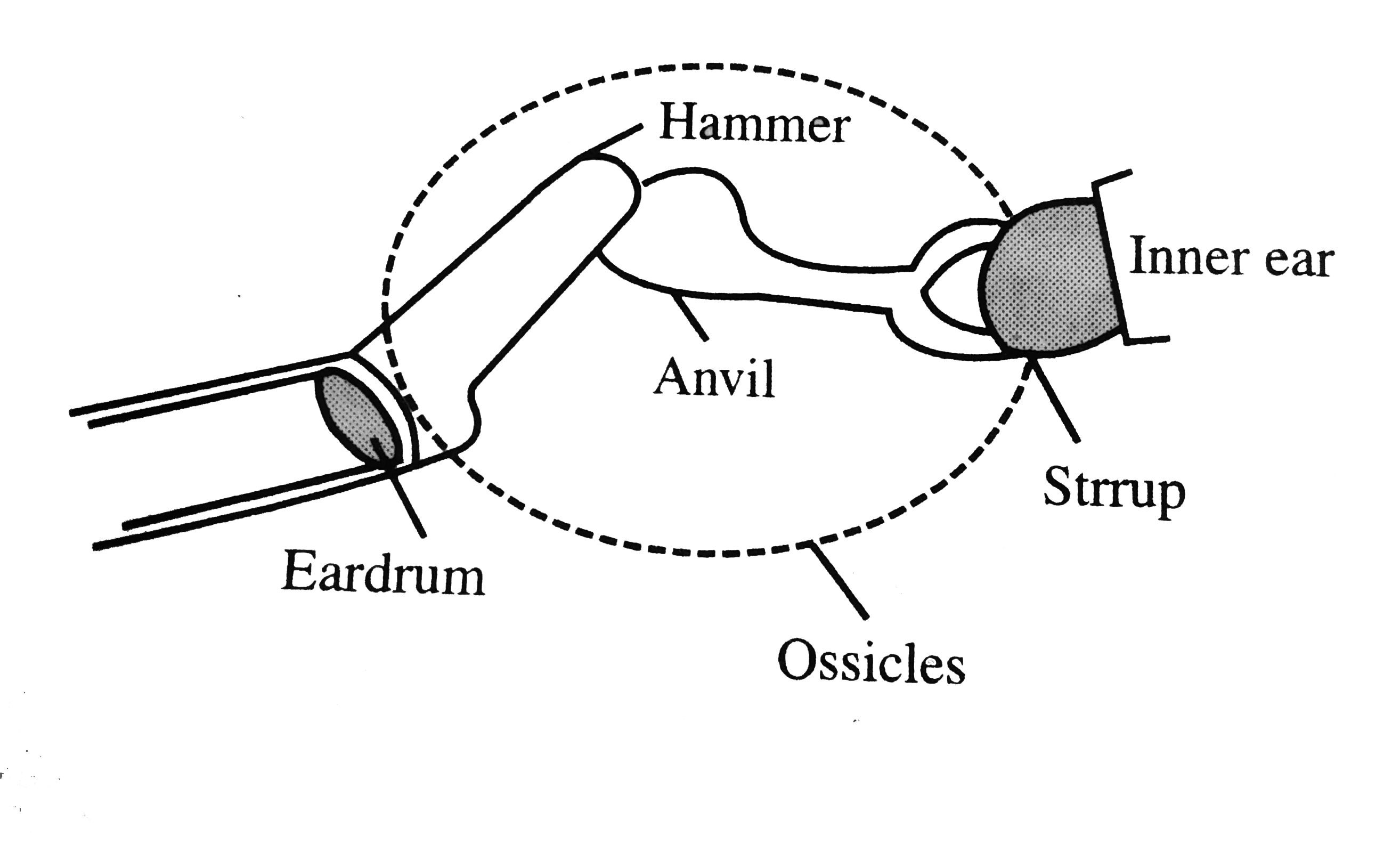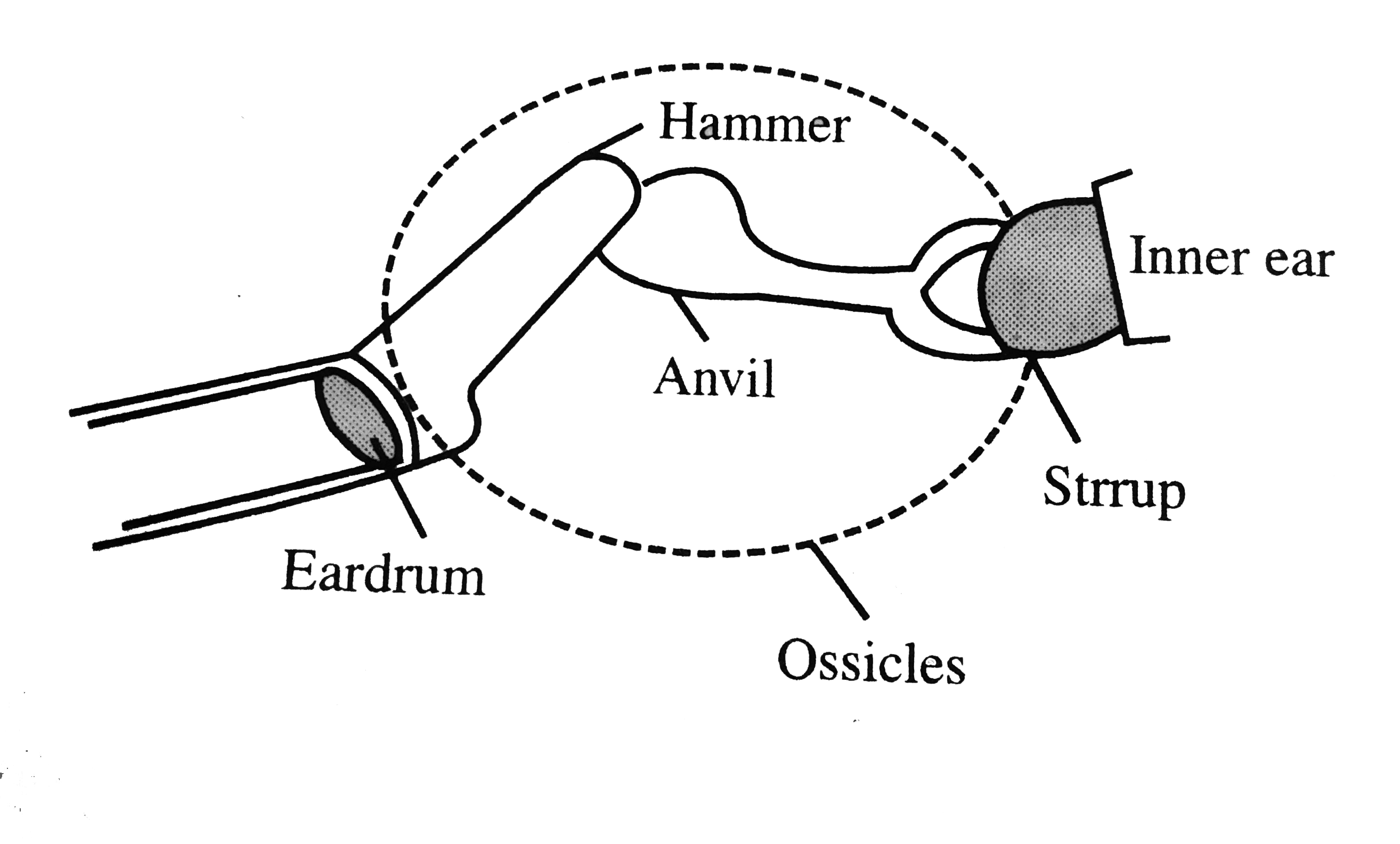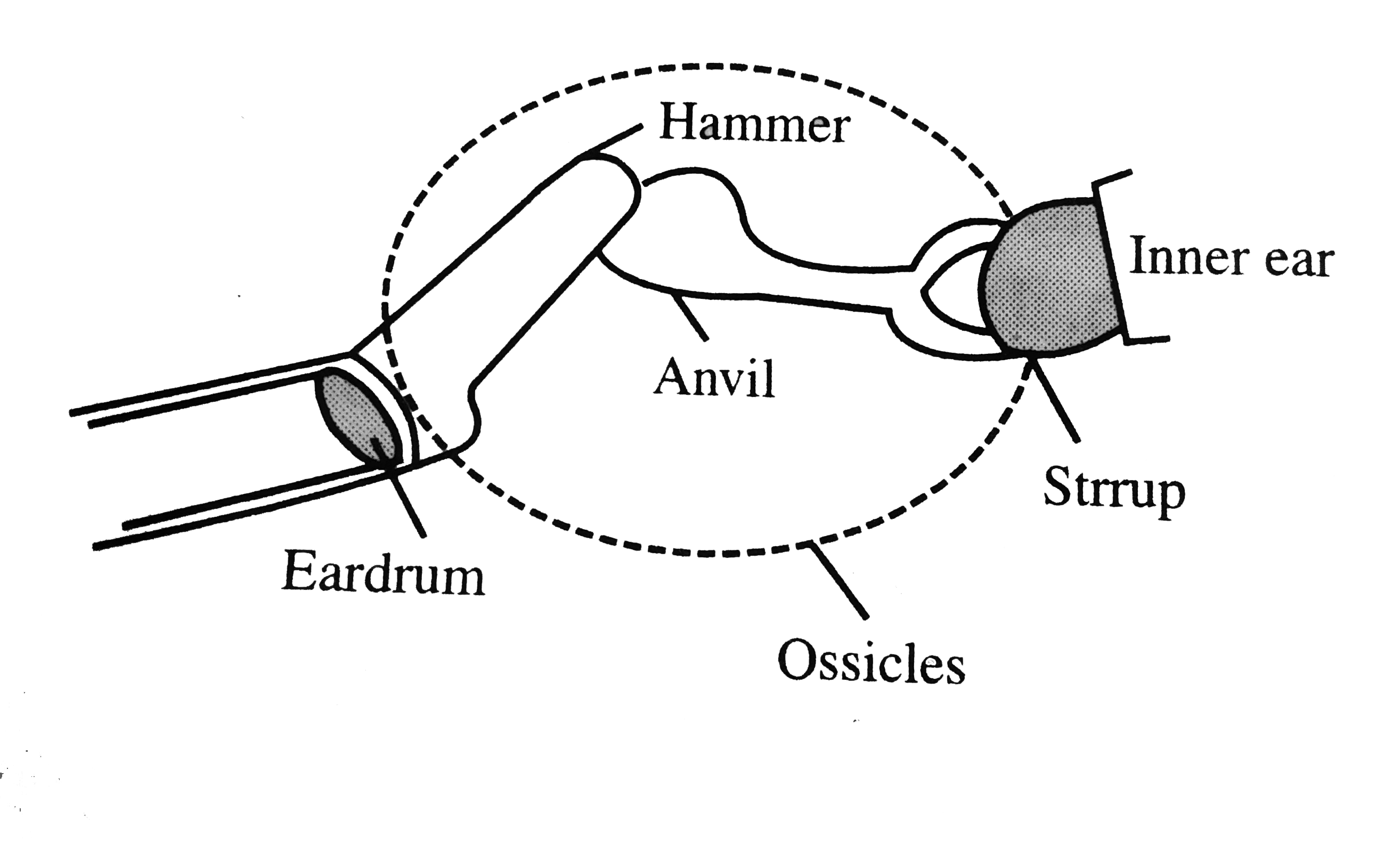hammer, anvil, pinna, stirrup
Step-by-Step Solution:
1. Identify the Components:
The question lists four terms: hammer, anvil, pinna, and stirrup.
2. Understand Their Context:
These terms are related to the anatomy of the ear. Specifically, they refer to different parts of the ear structure.
3. Define Each Component:
- Pinna: This is the external part of the ear made of cartilage. Its primary function is to collect sound waves and direct them into the ear canal for better hearing.
- Hammer (Malleus): This is one of the three tiny bones in the middle ear. It is shaped like a hammer and is responsible for transmitting sound vibrations from the eardrum to the anvil.
- Anvil (Incus): This is the second bone in the chain of the middle ear. It is shaped like an anvil and serves as a bridge between the hammer and the stirrup, passing on the vibrations.
- Stirrup (Stapes): This is the third bone in the middle ear, shaped like a stirrup. It connects to the inner ear and helps transmit sound vibrations to the cochlea.
4. Summarize Their Functions:
All these components work together to facilitate the process of hearing. The pinna collects sound, while the hammer, anvil, and stirrup amplify and transmit sound vibrations to the inner ear.
5. Conclusion:
Hammer, anvil, pinna, and stirrup are all parts of the ear, each playing a crucial role in the hearing process.
---
The question lists four terms: hammer, anvil, pinna, and stirrup.
These terms are related to the anatomy of the ear. Specifically, they refer to different parts of the ear structure.
- Pinna: This is the external part of the ear made of cartilage. Its primary function is to collect sound waves and direct them into the ear canal for better hearing.
- Hammer (Malleus): This is one of the three tiny bones in the middle ear. It is shaped like a hammer and is responsible for transmitting sound vibrations from the eardrum to the anvil.
- Anvil (Incus): This is the second bone in the chain of the middle ear. It is shaped like an anvil and serves as a bridge between the hammer and the stirrup, passing on the vibrations.
- Stirrup (Stapes): This is the third bone in the middle ear, shaped like a stirrup. It connects to the inner ear and helps transmit sound vibrations to the cochlea.
All these components work together to facilitate the process of hearing. The pinna collects sound, while the hammer, anvil, and stirrup amplify and transmit sound vibrations to the inner ear.
Hammer, anvil, pinna, and stirrup are all parts of the ear, each playing a crucial role in the hearing process.
Topper's Solved these Questions
- HUMAN BODY: THE NERVOUS SYSTEMBook:ICSEChapter:HUMAN BODY: THE NERVOUS SYSTEMExercise:EXERCISES (SECTION I (STATE THE EXACT LOCATIONS OF THE FOLLOWING))
Explore 5 Videos
- HUMAN BODY: THE NERVOUS SYSTEMBook:ICSEChapter:HUMAN BODY: THE NERVOUS SYSTEMExercise:EXERCISES (SECTION II (EXPLAIN THE FOLLOWING TERMS))
Explore 5 Videos
- HUMAN BODY: THE NERVOUS SYSTEMBook:ICSEChapter:HUMAN BODY: THE NERVOUS SYSTEMExercise:EXERCISES (SECTION I )
Explore 1 Video
- HUMAN BODY: THE EXCRETORY SYSTEMBook:ICSEChapter:HUMAN BODY: THE EXCRETORY SYSTEMExercise:PICTURE STUDY
Explore 9 Videos
- KINGDOM CLASSIFICATION IBook:ICSEChapter:KINGDOM CLASSIFICATION IExercise:EXERCISES (SECTION II (LONG ANSWER QUESTIONS))
Explore 8 Videos
Similar Questions

When a sound wave enters the ear, it sets the eardrum into oscillation, which in turn causes oscillation of 3 tiny bones in the middle ear called ossicles. This oscillation is finally transmitted to the fluid filled in inner portion of the ear termed as inner ear, the motion of the fluid disturbs hair cells within the inner ear which transmit nerve impulses to the brain with the information that a sound is present. The theree bones present in the middle ear are named as hammer, anvil and stirrup. Out of these the stirrup is the smallest one and this only connects the middle ear to inner ear as shown in the figure below. The area of stirrup and its extent of connection with the inner ear limits the sensitivity of the human ear consider a person's ear whose moving part of the eardrum has an area of about 50mm2 and the area of stirrup is about 5mm2. The mass of ossicles is negligible. As a result, force exerted by sound wave in air on eardum and ossicles is same as the force exerted by ossicles on the inner ear. Consider a sound wave having maximum pressure fluctuation of 4×10−2Pa from its normal equilibrium pressure value which is equal to 105Pa. Frequency of sound wave in air is 332ms. Velocity of sound wave in fluid (present in inner ear) is 1500ms. Bulk modulus of air is 1.42×105Pa. Bulk modulus of fluid is 2.18×109Pa.
Q. If the person is using an hearing aid, which increase the sound intensity level by 30 dB, then by what factor the intensity of given sound wave change as perceived by inner ear?
View Solution
When a sound wave enters the ear, it sets the eardrum into oscillation, which in turn causes oscillation of 3 tiny bones in the middle ear called ossicles. This oscillation is finally transmitted to the fluid filled in inner portion of the ear termed as inner ear, the motion of the fluid disturbs hair cells within the inner ear which transmit nerve impulses to the brain with the information that a sound is present. The theree bones present in the middle ear are named as hammer, anvil and stirrup. Out of these the stirrup is the smallest one and this only connects the middle ear to inner ear as shown in the figure below. The area of stirrup and its extent of connection with the inner ear limits the sensitivity of the human ear consider a person's ear whose moving part of the eardrum has an area of about 50mm2 and the area of stirrup is about 5mm2. The mass of ossicles is negligible. As a result, force exerted by sound wave in air on eardum and ossicles is same as the force exerted by ossicles on the inner ear. Consider a sound wave having maximum pressure fluctuation of 4×10−2Pa from its normal equilibrium pressure value which is equal to 105Pa. Frequency of sound wave in air is 332ms. Velocity of sound wave in fluid (present in inner ear) is 1500ms. Bulk modulus of air is 1.42×105Pa. Bulk modulus of fluid is 2.18×109Pa.
Q. This person (without hearing aid machine) is sitting inside a busy restaurant where average sound intensity is 3.2×10−5Wm2. How much energy in the form of sound is taken up by the person in his meal time of 1 h?
View Solution
When a sound wave enters the ear, it sets the eardrum into oscillation, which in turn causes oscillation of 3 tiny bones in the middle ear called ossicles. This oscillation is finally transmitted to the fluid filled in inner portion of the ear termed as inner ear, the motion of the fluid disturbs hair cells within the inner ear which transmit nerve impulses to the brain with the information that a sound is present. The theree bones present in the middle ear are named as hammer, anvil and stirrup. Out of these the stirrup is the smallest one and this only connects the middle ear to inner ear as shown in the figure below. The area of stirrup and its extent of connection with the inner ear limits the sensitivity of the human ear consider a person's ear whose moving part of the eardrum has an area of about 50mm2 and the area of stirrup is about 5mm2. The mass of ossicles is negligible. As a result, force exerted by sound wave in air on eardum and ossicles is same as the force exerted by ossicles on the inner ear. Consider a sound wave having maximum pressure fluctuation of 4×10−2Pa from its normal equilibrium pressure value which is equal to 105Pa. Frequency of sound wave in air is 332ms. Velocity of sound wave in fluid (present in inner ear) is 1500ms. Bulk modulus of air is 1.42×105Pa. Bulk modulus of fluid is 2.18×109Pa.
Q. With respect to information provided above, mark the correct statement.
View Solution
When a sound wave enters the ear, it sets the eardrum into oscillation, which in turn causes oscillation of 3 tiny bones in the middle ear called ossicles. This oscillation is finally transmitted to the fluid filled in inner portion of the ear termed as inner ear, the motion of the fluid disturbs hair cells within the inner ear which transmit nerve impulses to the brain with the information that a sound is present. The theree bones present in the middle ear are named as hammer, anvil and stirrup. Out of these the stirrup is the smallest one and this only connects the middle ear to inner ear as shown in the figure below. The area of stirrup and its extent of connection with the inner ear limits the sensitivity of the human ear consider a person's ear whose moving part of the eardrum has an area of about 50mm2 and the area of stirrup is about 5mm2. The mass of ossicles is negligible. As a result, force exerted by sound wave in air on eardum and ossicles is same as the force exerted by ossicles on the inner ear. Consider a sound wave having maximum pressure fluctuation of 4×10−2Pa from its normal equilibrium pressure value which is equal to 105Pa. Frequency of sound wave in air is 332ms. Velocity of sound wave in fluid (present in inner ear) is 1500ms. Bulk modulus of air is 1.42×105Pa. Bulk modulus of fluid is 2.18×109Pa.
Q. Find the displacement amplitude of given sound wave in the fluid of inner ear.
View Solution
When a sound wave enters the ear, it sets the eardrum into oscillation, which in turn causes oscillation of 3 tiny bones in the middle ear called ossicles. This oscillation is finally transmitted to the fluid filled in inner portion of the ear termed as inner ear, the motion of the fluid disturbs hair cells within the inner ear which transmit nerve impulses to the brain with the information that a sound is present. The theree bones present in the middle ear are named as hammer, anvil and stirrup. Out of these the stirrup is the smallest one and this only connects the middle ear to inner ear as shown in the figure below. The area of stirrup and its extent of connection with the inner ear limits the sensitivity of the human ear consider a person's ear whose moving part of the eardrum has an area of about 50mm2 and the area of stirrup is about 5mm2. The mass of ossicles is negligible. As a result, force exerted by sound wave in air on eardum and ossicles is same as the force exerted by ossicles on the inner ear. Consider a sound wave having maximum pressure fluctuation of 4×10−2Pa from its normal equilibrium pressure value which is equal to 105Pa. Frequency of sound wave in air is 332ms. Velocity of sound wave in fluid (present in inner ear) is 1500ms. Bulk modulus of air is 1.42×105Pa. Bulk modulus of fluid is 2.18×109Pa.
Q. Find the pressure amplitude of given sound wave in the fluid of inner ear.
View Solution
When a sound wave enters the ear, it sets the eardrum into oscillation, which in turn causes oscillation of 3 tiny bones in the middle ear called ossicles. This oscillation is finally transmitted to the fluid filled in inner portion of the ear termed as inner ear, the motion of the fluid disturbs hair cells within the inner ear which transmit nerve impulses to the brain with the information that a sound is present. The theree bones present in the middle ear are named as hammer, anvil and stirrup. Out of these the stirrup is the smallest one and this only connects the middle ear to inner ear as shown in the figure below. The area of stirrup and its extent of connection with the inner ear limits the sensitivity of the human ear consider a person's ear whose moving part of the eardrum has an area of about 50mm2 and the area of stirrup is about 5mm2. The mass of ossicles is negligible. As a result, force exerted by sound wave in air on eardum and ossicles is same as the force exerted by ossicles on the inner ear. Consider a sound wave having maximum pressure fluctuation of 4×10−2Pa from its normal equilibrium pressure value which is equal to 105Pa. Frequency of sound wave in air is 332ms. Velocity of sound wave in fluid (present in inner ear) is 1500ms. Bulk modulus of air is 1.42×105Pa. Bulk modulus of fluid is 2.18×109Pa.
Q. Find the displacement amplitude of given sound wave in the fluid of inner ear.
View SolutionA mammal lacking pinna is
View SolutionWhich of the following are chemical changes?
(i) Decaying of wood
(ii) Burning of wood
(iii) Sawing of wood
(iv) Hammering of a nail into a piece of wood
View SolutionGiven below are sets of five terms each. Rewrite the terms in correct order in a logical sequence.
Example : Large intestine, Stomach, Mouth, Small intestine, Oesophagus.
Answer : Mouth → Oesophagus → Stomach → Small intestine → Large intestine.
Cochlea, Malleus, Pinna, Stapes, Incus.
View SolutionMammalian pinna is supported by
View Solution